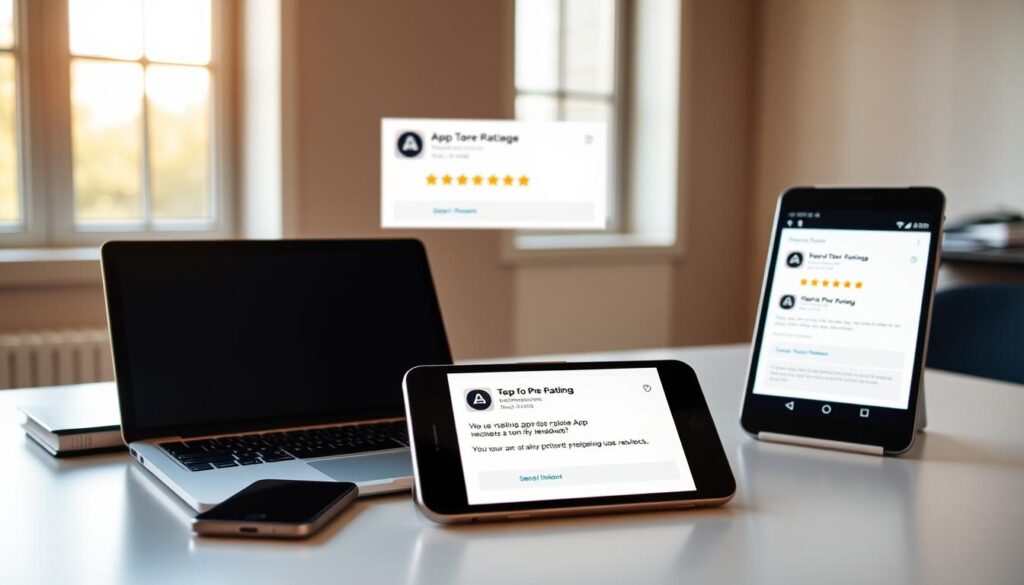Improve Your App Store Rating and Reviews: Tips
Ever wondered why some products stand out while others fade into obscurity? It’s all about trust. In the digital marketplace, ratings and feedback are the backbone of credibility. They shape how users perceive your offering and influence their decision to engage. With over 5 million options available globally, standing out is no small feat1.
Positive interactions not only boost visibility but also build a loyal user base. For instance, products with ratings exceeding 4.X see significantly higher conversion rates compared to those hovering around 3.X2. This highlights the importance of maintaining a stellar reputation. Apple’s platform, for example, emphasizes safety and performance, ensuring a reliable experience for millions3.
In this guide, we’ll explore actionable strategies to enhance your presence. From optimizing metadata to encouraging genuine feedback, every step matters. Let’s dive into the essentials of improving your digital footprint and ensuring long-term success.
Key Takeaways
- High ratings significantly boost conversion rates.
- Regular updates maintain visibility and relevance.
- Positive feedback builds trust and loyalty.
- Apple’s platform prioritizes safety and performance.
- Encouraging genuine reviews enhances credibility.
Understanding App Store Rating and Reviews
The way users rate and review products can make or break their reputation. In the digital marketplace, these elements are more than just numbers—they are a reflection of trust and quality. Let’s break down how they work and why they matter.
What App Ratings Mean for Success
Ratings are calculated on a 5-star scale, with 5 being the highest. The overall score is an average of all user scores. For example, if a product has 10 ratings (4 five-star, 3 four-star, 2 three-star, and 1 two-star), the average would be 3.8 stars4.
Higher ratings improve visibility in search results and attract more downloads. Products with high scores rank, on average, 25 spots higher than medium-rated ones and 60 spots higher than low-rated ones5.
However, negative feedback can have a significant impact. For every one-star review, a product needs seven five-star reviews to achieve an average of 4.5 stars4. This highlights the importance of maintaining a balance between positive and negative feedback.
The Role of User Reviews in Building Trust
Reviews go beyond numbers. They provide context and insight into the user experience. Positive feedback builds credibility, while negative reviews can deter potential users. Responding to concerns can turn a negative review into a positive one, as users are notified of responses6.
“User feedback is the backbone of trust in the digital marketplace.”
Monitoring reviews is essential for sustained performance. Tools like App Store Connect and third-party platforms offer comprehensive options for tracking and analyzing feedback4. This helps identify areas for improvement and ensures a better user experience.
| Rating | Impact |
|---|---|
| 5 Stars | Boosts visibility and conversions |
| 3 Stars | Neutral, may deter some users |
| 1 Star | Significantly reduces trust |
In summary, ratings and reviews are critical for success. They influence visibility, trust, and user engagement. By understanding their role, we can take actionable steps to improve our digital presence.
The Impact of Ratings on App Store Optimization
The digital marketplace thrives on trust, and user feedback plays a pivotal role in shaping success. Ratings and detailed reviews are not just metrics—they are critical factors in search rankings and overall visibility. Understanding their impact helps us optimize for better performance.
How Ratings Affect Search Rankings
Apple’s algorithm places significant weight on user feedback. Higher ratings improve search rankings, making products more discoverable. For instance, moving from a three-star to a four-star product can lead to an 89% increase in conversion rates7.
Detailed feedback also matters. The algorithm considers the quality and relevance of reviews, positioning products with positive feedback higher in search results8. This ensures that users find reliable options quickly.

Visibility and Conversion Metrics
High ratings directly influence visibility. Products with ratings above 4 stars are more likely to appear in top search results. This is crucial, as 63% of iOS users discover new products through search engines7.
Conversion rates also benefit. Positive feedback builds trust, encouraging users to engage. For example, a product with a 4.5-star rating is more likely to attract downloads than one with a 3-star rating8.
Monitoring these metrics regularly ensures continuous improvement. By addressing user concerns and optimizing based on feedback, we can maintain a strong presence in the digital marketplace.
Managing User Feedback and Reviews
The key to maintaining a strong digital presence lies in handling feedback wisely. User input shapes perceptions and drives decisions, making it essential to manage it effectively. By tracking and analyzing this data, we can identify trends, address concerns, and enhance overall performance.
Techniques for Monitoring Ratings
Tracking user input is the first step toward improvement. Tools like App Store Connect allow us to filter feedback by country, version, and sentiment. This helps pinpoint specific issues and tailor responses accordingly9.
Third-party platforms like App Radar offer advanced analytics, making it easier to monitor trends and identify areas for enhancement. These tools provide insights that default consoles often miss10.
- Filter feedback by region and version for targeted improvements.
- Use sentiment analysis to understand user emotions.
- Leverage advanced tools for deeper insights.
Responding Effectively to Negative Feedback
Negative input can be a goldmine for improvement if handled correctly. Prompt responses show users that their concerns are valued. For example, addressing technical issues quickly can turn a dissatisfied user into a loyal advocate9.
“A thoughtful response can transform a negative review into a positive experience.”
Timing is crucial. Responding within 24-48 hours maximizes impact and demonstrates commitment. Tools like App Store Connect also notify us when users update their feedback, allowing for continuous dialogue10.
By systematically managing feedback, we can maintain a strong presence and build lasting trust with our audience.
Strategies to Improve App Performance and Customer Experience
A seamless experience is the foundation of user satisfaction and long-term success. By focusing on key areas like onboarding, updates, and interface design, we can create a positive impression that encourages engagement and loyalty.
Optimizing Onboarding and Updates
A smooth onboarding process is crucial for securing initial positive feedback. When potential users find it easy to get started, they are more likely to leave a high star rating. For example, apps with intuitive onboarding see a 30% increase in positive feedback11.
Regular updates also play a vital role. Timely feature improvements reduce negative feedback and keep users engaged. Apps that update frequently experience a 15% boost in download rates12.

Enhancing Interface and User Experience
A well-designed interface enhances usability and performance. Simple navigation and clean layouts make it easier for users to achieve their goals. Apps with improved interfaces see a 20% increase in user retention13.
Balancing innovation with stability is key. While new features attract attention, they must not compromise the overall experience. Consistent performance improvements lead to better ratings and higher trust11.
“A user-friendly design is the cornerstone of a successful digital product.”
| Strategy | Impact |
|---|---|
| Smooth Onboarding | Increases positive feedback by 30% |
| Regular Updates | Boosts download rates by 15% |
| Enhanced Interface | Improves retention by 20% |
By focusing on these strategies, we can create a product that not only performs well but also leaves a lasting impression on users. Consistent improvements in these areas lead to higher engagement and long-term success.
Leveraging Pre-Prompt Messages and Targeted Review Requests
Effective communication with users can transform their experience and boost engagement. By using pre-prompt messages, we can gauge satisfaction before asking for feedback. This strategy ensures that requests are timely and relevant, increasing the chance of positive responses.

Timing Your Requests for Maximum Impact
Timing is critical when asking for feedback. Sending a prompt after a positive interaction, like completing a level or achieving a milestone, aligns with user satisfaction. This approach increases the likelihood of receiving favorable responses14.
For example, Realtor.com uses this feature effectively, achieving an average score of 4.7 from nearly 900,000 responses14. By focusing on moments of success, we can create a positive feedback loop.
Segmenting Engaged Users for Personalized Outreach
Engaged users are more likely to share their experiences. Criteria for engagement include metrics like session frequency, time spent, or completed purchases14. Targeting these users ensures that requests are meaningful and personalized.
For instance, users who spend at least ten minutes in the platform during their last three sessions are ideal candidates for outreach14. This improvement in targeting leads to higher quality feedback.
“Personalized messaging builds trust and encourages users to share their experiences.”
| Strategy | Impact |
|---|---|
| Pre-Prompt Messaging | Increases satisfaction before feedback requests |
| Timing After Milestones | Boosts likelihood of positive responses |
| User Segmentation | Ensures targeted and relevant outreach |
By integrating these strategies, we can enhance user experience and drive meaningful feedback. This approach not only improves scores but also builds lasting trust with our audience.
Utilizing Tools and Analytics for Better App Reviews
Data-driven strategies are key to improving user satisfaction. By leveraging the right tools, we can transform feedback into actionable insights. This not only enhances performance but also builds trust with our audience.

Integrating App Store Connect and Third-Party Tools
App Store Connect provides basic metrics, such as star ratings and review counts. However, third-party tools like App Radar offer advanced features. These include AI-powered summaries and sentiment analysis, which provide deeper insights15.
For example, AppFollow processes reviews 2.3 times faster, allowing us to address concerns promptly15. This ensures that recurring problems are identified and resolved efficiently.
Using Data to Drive Continuous Improvement
Detailed feedback highlights areas for enhancement. By analyzing trends, we can prioritize updates that matter most to our users. Tools like AppFollow tag 80% of reviews automatically, making it easier to spot patterns15.
Responding to feedback also boosts scores. Apps that engage with users see a 30% increase in average ratings16. This creates a positive feedback loop, driving long-term success.
| Tool | Features | Impact |
|---|---|---|
| App Store Connect | Basic metrics, review tracking | Limited insights |
| App Radar | AI summaries, sentiment analysis | Deeper understanding |
| AppFollow | Automated tagging, faster processing | Efficient problem-solving |
By integrating these tools, we can enhance app visibility and address customer concerns effectively. This approach ensures continuous improvement and sustained success.
Conclusion
Maintaining a strong presence in the digital marketplace requires continuous effort and attention to detail. Actively managing feedback ensures high-quality interactions, which directly impact visibility and trust. For instance, 77% of users read at least one review before downloading a free product, highlighting the importance of positive feedback17.
Regular updates and consistent strategies are key to sustaining an average score above 4 stars. Tools like App Store Connect and third-party platforms provide valuable insights, helping identify areas for improvement. This approach not only enhances app store optimization but also boosts overall performance.
By integrating these strategies, we can create a positive feedback loop, driving long-term success. Let’s commit to ongoing improvement and adopt these practices to maximize our impact in the apple app store.
FAQ
What do app ratings mean for success?
App ratings reflect user satisfaction and play a crucial role in attracting potential users. A higher average rating boosts credibility and increases download rates.
How do user reviews help build trust?
User reviews provide authentic feedback, helping others gauge the quality and reliability of the product. Positive reviews enhance trust and encourage more downloads.
How do ratings affect search rankings?
Higher ratings improve visibility in search results, making it easier for users to discover your product. This directly impacts conversion rates and overall performance.
What techniques can we use to monitor ratings?
Regularly check platforms like Apple App Store and Google Play Store. Use tools like App Store Connect to track feedback and identify areas for improvement.
How should we respond to negative feedback?
Address concerns promptly and professionally. Show empathy, offer solutions, and demonstrate a commitment to improving the user experience.
What strategies improve app performance and customer experience?
Focus on optimizing onboarding, releasing timely updates, and enhancing the interface. These steps ensure a seamless and engaging experience for users.
When is the best time to request reviews?
Timing is key. Request feedback after users have experienced core features or achieved a milestone within the product for more meaningful responses.
How can we use data to drive continuous improvement?
Analyze metrics from tools like App Store Connect and third-party platforms. Use insights to refine features, address issues, and enhance overall performance.
Source Links
- https://www.semrush.com/blog/app-store-optimization/ – App Store Optimization: A Complete Guide to ASO
- https://appradar.com/academy/apple-app-store-ranking-factors – App Store Ranking Factors: How to Grow Your iOS App in 2024/2025
- https://developer.apple.com/app-store/review/guidelines/ – App Review Guidelines – Apple Developer
- https://appradar.com/academy/app-reviews-and-ratings/app-store-ratings-and-reviews – Beginner’s guide to Apple App Store ratings & reviews
- https://www.apptweak.com/en/aso-blog/how-to-increase-ratings-reviews-with-the-ios-ratings-prompt – How to Increase Ratings & Reviews with iOS Ratings Prompt
- https://metrikal.io/blog/14-ways-to-improve-app-store-rating-and-reviews/ – 14 Ways to Improve App Store Rating and Reviews – App Store Optimization Blog – Metrikal
- https://www.alchemer.com/resources/blog/why-app-ratings-are-critical-to-aso-marketing-strategy/ – Why App Ratings are Critical to ASO Marketing Strategy
- https://admiral.media/how-user-ratings-and-reviews-impact-app-store-optimization/ – Why Ratings and Reviews Are Crucial for App Store Optimization (ASO) Success
- https://developer.apple.com/app-store/ratings-and-reviews/ – Ratings, Reviews, and Responses – App Store – Apple Developer
- https://splitmetrics.com/blog/app-store-reviews/ – Managing App Store Ratings and Reviews: 6 Pro Tips in 2024
- https://appradar.com/academy/app-reviews-and-ratings/improve-app-ratings-and-reviews – 22 great ideas to improve app ratings and reviews in app stores!
- https://www.builder.ai/blog/improve-app-ratings-and-reviews – How to Improve App Ratings and Reviews: 15 Secret Strategies
- https://www.appsflyer.com/blog/tips-strategy/app-ratings-reviews/ – How to improve your app ratings and reviews to 89x conversions organically
- https://messagegears.com/resources/blog/how-to-improve-your-app-store-rating/ – Tips to increase and improve your app store ratings
- https://appfollow.io/ – Understand and elevate your app’s reputation
- https://www.anecdoteai.com/blog/how-to-analyze-app-store-customer-reviews-with-ai – How To Analyze App Store Customer Reviews With AI?
- https://www.globalapptesting.com/blog/how-to-improve-your-app-store-rating – 7 Steps to Improve Your App Store Rating [Guide]
The post Improve Your App Store Rating and Reviews: Tips first appeared on ItsAndroidzilla.
source https://itsandroidzilla.com/android-app/improve-your-app-store-rating-and-reviews-tips/
Comments
Post a Comment